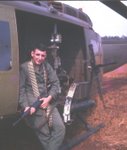Another resupply mission that was particularly harrowing occurred when we were working for a unit close to Dak To.
It was late afternoon and got a call to divert to another units fire base for an emergency ammo resupply. We were not aware that the unit was in heavy contact but when we checked in with them we could hear all the weapons fire and general chaotic noise of an ongoing battle.
As we made our approach to the pad on the side of the mountain we realized what we had gotten into. The firebase was swarming with activity from the defensive positions and nearly everyone seemed to be actively firing their M-16’s, grenade launchers or throwing fragmentation grenades toward the perimeter wire closest to the helipad. After we unloaded the ammo and were getting ready to leave, the helipad started receiving mortar hits that were so close they caused our aircraft to lurch sideways. We could clearly see and hear the “Shooom” as the rounds impacted and the sound of the shrapnel as it sprayed the helicopter.
I thought for certain that we wouldn’t be able to get away without major damage or worse. When we finally got stabilized we got a call asking us to try to put some fire on a bunch of gooks right next to the perimeter wire we were closest to. Still at a hover, we maneuvered almost directly over the perimeter and spotted a group of uniformed NVA that were readying a mortar or some other form of weapon. Our crew chief and gunner depressed their M-60’s almost straight down and engaged the gooks. We had to turn from side to side to allow them a clear shot at the now retreating enemy which still had the wherewithal to engage us with their AK’s. We took several rounds through the “chin bubbles” or lower front windows directly in front of our feet that impacted the flack vests placed there for this very situation. One of the two inverters took at least one hit and this caused the master caution to illuminate. We pulled the circuit breaker for the inverter as a safety precaution and the master caution turned off.
The firefight ended abruptly with the gooks slipping back into the foliage at the edge of the perimeter. The outgoing fire continued sporadically from the firebase and our crew chief and gunner continued to fire until their M-60’s were expended.
We called for permission to depart and were thanked profusely for our help which made us pretty happy as we made our way back to Dak To to refuel and check out the bird. We had developed a high frequency vibration that indicated some sort of tail rotor problem,could hear the distinctive "whoosh-whoosh" noise that a main rotor blade makes when it sustains damage and the crew chief said there was fluid streaming back along the tail boom and he figured it was either transmission or hydraulic oil. I also discovered that I had taken some shrapnel in my ankles and lower legs and was bleeding through the nylon sides and water vents of my jungle boots. No real pain as I recall, just a mess on the floor around the pedals where my feet were.
 Shrapnell damage
Shrapnell damageAfter refueling we shut down and checked over the Huey for damage. We had sustained numerous main and tail rotor hits, shrapnel damage to a large portion of the tail boom and a severely leaking hydraulic reservoir located on the engine deck. We didn’t fly this bird home but left it tied down to be sling loaded back to base camp by a Chinook the next day. (This Huey was a “hanger queen” for some time to come as it required main and tail rotor blade replacement, considerable sheet metal repair and patches, hydraulic line and reservoir replacement, two new chin bubbles and a new inverter and electrical repair. I eventually test flew this aircraft at the completion of all the repair work and it was again a fine flying aircraft that I credited with saving our lives. She became a favorite of the entire crew!)
 UH-1H engine shrapnel damage
UH-1H engine shrapnel damageBy then the adrenaline buzz was wearing off and we realized how close we had been to disaster. We had been so caught up in the action we never really thought about what could have happened. I believe that people in wartime circumstances react automatically, place themselves in great personal danger and take unthinkable risks, to wonder later if it all really happened.










 Oscar Tristan and me relaxing at Dalat.
Oscar Tristan and me relaxing at Dalat.


